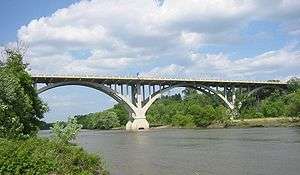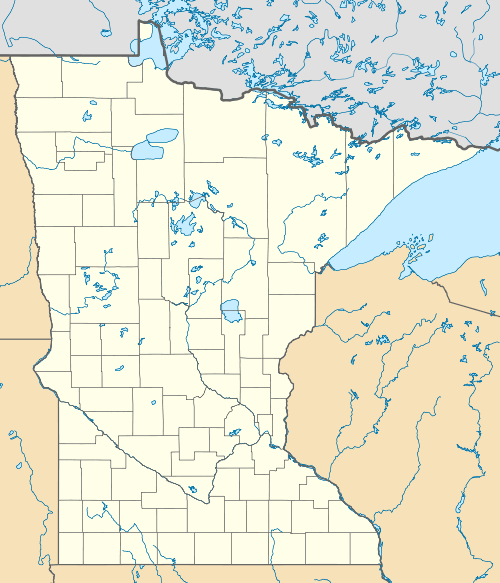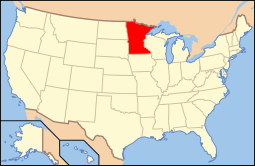Mendota Bridge
| Mendota Bridge | |
|---|---|
 Three spans of the Mendota Bridge as viewed from the west side, in Fort Snelling State Park. | |
| Coordinates | 44°53′14″N 93°10′39″W / 44.887341°N 93.177564°WCoordinates: 44°53′14″N 93°10′39″W / 44.887341°N 93.177564°W |
| Carries |
Four lanes of |
| Crosses | Minnesota River |
| Locale | Minneapolis-St. Paul, Minnesota |
| Maintained by | Minnesota Department of Transportation |
| ID number | 4190 |
| Characteristics | |
| Design | 13 arch spans |
| Total length | 4,113 ft (1,254 m)[1] |
| Width | 71 ft (22 m) |
| Longest span | 304 ft (93 m)[1] |
| Clearance below | 100 ft (30 m) |
| History | |
| Opened | 1926, 1994 |
| Statistics | |
| Daily traffic | 39000 vehicles/day |
 | |
The Mendota Bridge (full name Fort Snelling – Mendota Bridge) carries Minnesota State Highway 55 over the Minnesota River between Fort Snelling and Mendota Heights. It is the final bridge over the Minnesota River before the Minnesota flows into the Mississippi River at the "Meeting of the waters" or "Mendota" in the Dakota language. Traffic on the north end of the bridge may turn onto the Fort Road Bridge (MN 5) to cross the Mississippi River into St. Paul, Minnesota. The skylines of both Minneapolis and St. Paul can be seen simultaneously from the bridge.
History
The structure was designed by C.A.P. Turner and Walter H. Wheeler.[2] Turner also designed the Aerial Lift Bridge in Duluth, Minnesota and the Liberty Memorial Bridge between Bismarck and Mandan, North Dakota.
The bridge is dedicated to the "Gopher Gunners", 151st Field Artillery who died in World War I.[3]
It has a length of 4,113 feet (1,254 m) and was the longest continuous concrete arch bridge in the world when it was constructed in 1924–1926. It consists of thirteen arches each 304 ft (93 m) wide.[1] It was added to the National Register of Historic Places in 1979.
Between 1940 and 1965, the bridge also carried the multiplexed designation of Highway 100.
From 1992–1994, the old bridge was demolished down to the arches and rebuilt from the arches up with the new wider deck two feet higher than the original.

See also
References
- 1 2 3 MN/DoT 2006, p. 1.
- ↑ Frame 2006, pp. 1–2.
- ↑ "Historic Sites: Mendota". Dakota County Historical Society. Retrieved January 1, 2012.
- Citations
- MN/DoT (June 15, 2006). "Bridge Number 4190: Executive summary" (PDF). Historic Bridge Management Plan. Minnesota Department of Transportation. Retrieved December 7, 2015.
- Frame, Robert M. (April 27, 2006). "Bridge Number 4190" (PDF). Minnesota Historic Property Records. Retrieved December 7, 2015.
External links
| Wikimedia Commons has media related to Mendota Bridge. |
- Mendota Bridge in Highways, Byways, And Bridge Photography
- National Bridge Inventory


